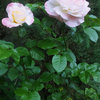rose has white variegated leaves
thahalibut
13 years ago
Featured Answer
Sort by:Oldest
Comments (35)
marbree
13 years agoRelated Discussions
White spots and holes on rose leaves
Comments (9)Rose slugs are chewing off the lower surface of the leaves, leaving the top membrane as a translucent white window. Just wipe them off with your thumb, or spray with spinosad. Buford, I'm surprised an experienced grower like you isn't familiar with these. Your own garden must have some magical power to repel sawflies....See MoreRose with pink/white/green variegated leaves
Comments (4)Or you have a rose with one of the variations of Rose Mosaic Virus. Usually roses with one kind of RMV have yellow zigzags; I've seen that zigzag pattern in pink twice: the first time was on several Dream roses ( Jerry Twomey's intros in the early 1990s) The roses weren't in bloom so I can't tell you which color had the pink zigzag. A couple of years later someone in Ohio spotted the pink zigzag on one of their Hybrid Teas. If your rose's problem is RMV, it could account for the lack of vigor in your plant....See Morevariegated leaves
Comments (22)Harrison, sounds like you have a H. Carnosa Krimson Queen. Here is a picture of mine. I've had her about 13 years, still small because she grows very slow. Good hoya this one is. The blooms smell like chocolate. This year I put her in a north facing window because my west-facing garden window was making her leaves turn light yellow from too much light/direct sun. Now her leaves are getting dark green and looking healthier. This is a good hoya that is very easy to care for, just don't water too much during the winter and water 2X a week in the summer. TammyPie...See MoreVariegated iris leaves, white or yellow?
Comments (6)No, they will not change their variegation. Also, irises with yellow variegation are more robust, grow and multiply quicker and overall look healthier than the irises with white variegation. On the picture below, you can see 3 of my variegated irises: 2 with yellow stripes and one with white. Growing conditions are identical. But Yellow-striped are twice as big, 3 times more flowers and are pretty much ready to be divided by their third year while the white-variegated are somewhat dwarfish and a very mediocre bloomer:...See Moreamandahugg
13 years agokstrong
13 years agomarbree
13 years agoolga_6b
13 years agothahalibut
13 years agokstrong
13 years agoFrozeBudd_z3/4
13 years agohenry_kuska
13 years agokstrong
13 years agohenry_kuska
13 years agomeredith_e Z7b, Piedmont of NC, 1000' elevation
13 years agobethnorcal9
13 years agomike_rivers
13 years agoFrozeBudd_z3/4
13 years agohoovb zone 9 sunset 23
13 years agoUser
13 years agoanntn6b
13 years agoFrozeBudd_z3/4
13 years agoprofessorroush
13 years agohenry_kuska
13 years agothahalibut
13 years agotaoseeker
13 years agomarbree
13 years agotaoseeker
13 years agoamandahugg
13 years agotaoseeker
13 years agomarbree
13 years agothahalibut
13 years agoFrozeBudd_z3/4
13 years agothahalibut
12 years agoamandahugg
12 years agoroseseek
12 years agoMichael Lobo
2 years ago
Related Stories

COLORS OF THE YEARPantone Has Spoken: Rosy and Serene Are In for 2016
For the first time, the company chooses two hues as co-colors of the year
Full Story
COTTAGE STYLEHouzz Tour: Snug London Cottage Has a Spacious Feel
Natural light, an ingenious layout and plenty of space-saving tricks are the secrets to this compact home’s laid-back charm
Full Story
LIFEHouzz Call: What Has Mom Taught You About Making a Home?
Whether your mother taught you to cook and clean or how to order takeout and let messes be, we'd like to hear about it
Full Story
FALL GARDENING5 Ways to Put Fall Leaves to Work in Your Garden
Improve your soil and yard the organic way with a valuable garden booster that grows on trees
Full Story
GARDENING GUIDESWhat's Wrong With My Plant? Leaves Often Hold the Clues
Learn how to identify common plant ailments by reading their leaves
Full Story
ARCHITECTUREStates of Style: Alabama’s Icons Leave Their Mark
In the first of a new series, discover the natural beauty, the architectural icons and some of our favorite homes deep in the heart of Dixie
Full Story
GARDENING GUIDESWhat Kind of Roses Should You Grow?
Want to add the beauty of roses to your garden? Find out which ones, from old-fashioned to modern, are right for you
Full Story
PLANTING IDEASGreat Garden Combo: Rose + Clematis for Small-Space Impact
We all need somebody to lean on. And when a rose supports a climbing vine, the results can totally transform a small garden
Full Story
WINTER GARDENINGPruning Secrets for Exquisite Roses
Encourage gorgeous blooms year after year with this time-tested advice on how to prune your rosebush in winter for health and shape
Full Story
GARDENING GUIDES6 Wonderfully Easy Roses for Any Gardener
Look like an expert even if you're just starting out, with these low-maintenance gems of the rose world
Full Story





kstrong